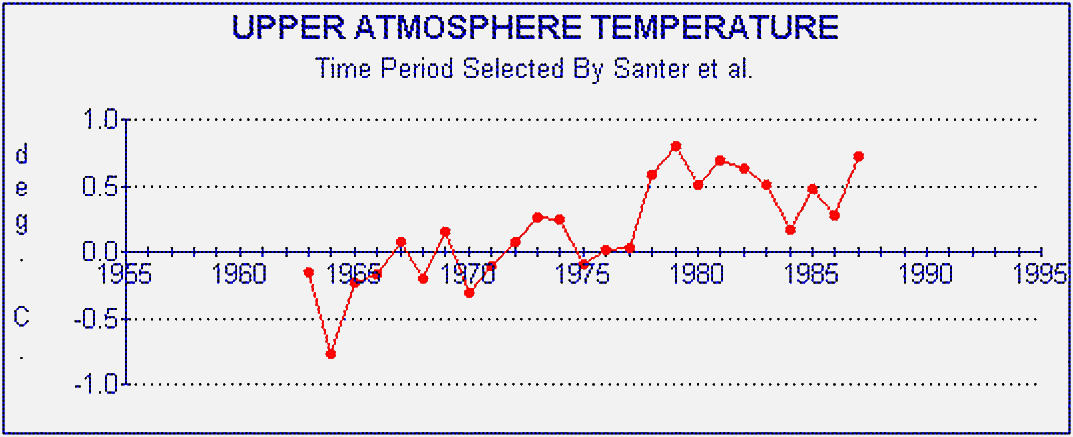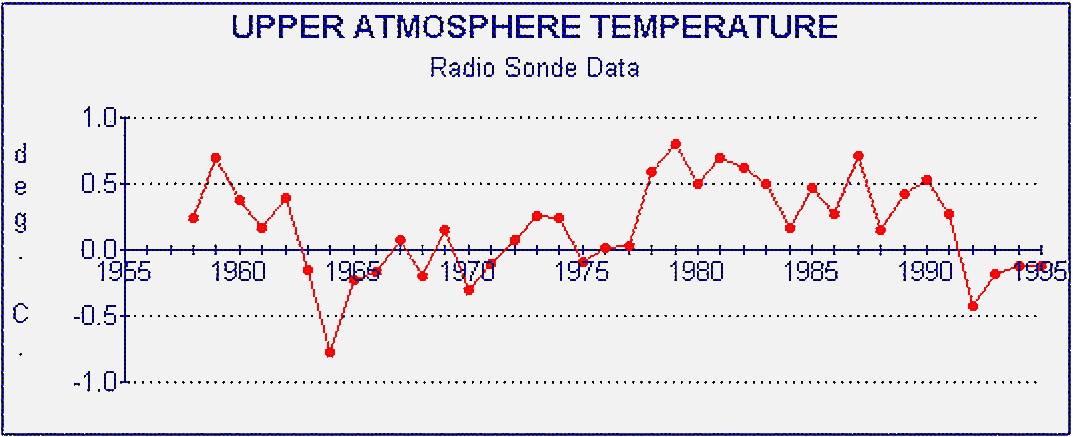|
 Santer et al choose the dates in the upper graph as a basis on which to compare observed
conditions against those that the models would predict. Since the models predict upper troposphere
warming under enhanced Greenhouse conditions, it was necessary to show that observed data agreed with
the models, thus validating those models and proving that the Greenhouse human fingerprint was already
evident. Santer et al choose the dates in the upper graph as a basis on which to compare observed
conditions against those that the models would predict. Since the models predict upper troposphere
warming under enhanced Greenhouse conditions, it was necessary to show that observed data agreed with
the models, thus validating those models and proving that the Greenhouse human fingerprint was already
evident.
 When the full available time period of radio sonde data is shown (Nature, vol.384, 12
Dec 96, p522) we see that the warming indicated in Santer's version is just a
product of the dates chosen. The full time period shows little change at all to the data over a
longer 38-year time period extending both before Santer et al''s start year, and extending after
their end year. When the full available time period of radio sonde data is shown (Nature, vol.384, 12
Dec 96, p522) we see that the warming indicated in Santer's version is just a
product of the dates chosen. The full time period shows little change at all to the data over a
longer 38-year time period extending both before Santer et al''s start year, and extending after
their end year.
 And
which version should we trust? The simple rule in all cases like this is - And
which version should we trust? The simple rule in all cases like this is -
The longer the time span of a data series, the
more reliable is the underlying trend
 It was 5 months before `Nature' published two rebuttals from other
climate scientists, exposing the faulty science employed by Santer et al. (Vol.384, 12 Dec
1996). The first was from Prof Patrick Michaels and Dr Paul Knappenberger, both of the
University of Virginia, who said in part - It was 5 months before `Nature' published two rebuttals from other
climate scientists, exposing the faulty science employed by Santer et al. (Vol.384, 12 Dec
1996). The first was from Prof Patrick Michaels and Dr Paul Knappenberger, both of the
University of Virginia, who said in part -
"When we examine the period of record used
by Santer et al. (1st graph) in the context of the longer period available from ref.5 (2nd graph), we find that in the region with the most
significant warming (30-600 S.
850-300 hPa), the increase is largely an artefact of the time period
chosen"
 The second rebuttal was from a German scientist, Gerd R. Weber, who drew attention to the fact that even the period of warming chosen by
Santer et al could itself be explained thus - The second rebuttal was from a German scientist, Gerd R. Weber, who drew attention to the fact that even the period of warming chosen by
Santer et al could itself be explained thus -
"Regarding the role of natural factors, the early
years of the period 1963-87 were substantially influenced by tropospheric cooling (and stratospheric
warming) following the eruption of Mount Agung, whereas the end of that period was influenced by
several strong El Nino events, which have led to some tropospheric warming and stratospheric cooling,
particularly in the southern subtropics of the lower latitudes. Therefore the general tropospheric
warming and stratospheric cooling trend between 1963 and 1987 has been accentuated by widely known
natural factors and could at least partially be explained by them."
 In other words, even the warm trend selected out by Santer et
al was itself largely explainable by known natural events and not induced through any man-made
cause. In other words, even the warm trend selected out by Santer et
al was itself largely explainable by known natural events and not induced through any man-made
cause.
 So,
did Santer et al really discover a "discernible human influence on
global climate" ? Hardly. The obvious intent inherent in the paper's title, mounting
external pressures for some unambiguous sign of human climatic impact, and the choice of a time period
which just happened to show a warming phase in an otherwise neutral longer-term record, indicates only
that there is today "a discernible human influence on global climate change
science". So,
did Santer et al really discover a "discernible human influence on
global climate" ? Hardly. The obvious intent inherent in the paper's title, mounting
external pressures for some unambiguous sign of human climatic impact, and the choice of a time period
which just happened to show a warming phase in an otherwise neutral longer-term record, indicates only
that there is today "a discernible human influence on global climate change
science".
|




